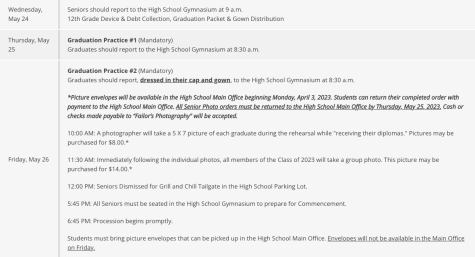Chemistry elective faces low enrollment
Photo submitted by Mrs. Stephanie Linz
Students performed a distillation lab where acetone was distilled and separated from water to create a pure fraction. All of the students were able to participate adequately.
March 22, 2023
Honors Organic Chemistry is an elective course that merely has six students. The elective runs every cycle day in the second semester and is taught by Mrs. Stephanie Linz in room 543.
The curriculum of the class is filled with multiple labs, assignments and tests. While Linz does have a preference for class sizes, the number of students in the class is not the determining factor in her inclination.
“I think it has more to do with the interest and involvement of the students than the class size,” Linz said. “I would prefer any size class where all of the students are interested in and participating over the opposite.”
In fact, Linz believes that these factors render the class a perfect size.
“Everyone in this particular class is interested in the material, asks questions and does their work,” Linz explained. “In terms of student interest, it’s just right.”
Moreover, senior Auna Land expressed positive sentiments about the class.
“I do enjoy the smaller class size. I have a friend, and it’s easier to talk to everyone together,” Land communicated.
Likewise, class size also affects labs that are conducted. This was recently seen when the students completed a lab that involved the distillation of an acetone-water fraction.
“We’re going to use fewer chemicals during lab,” Linz shared when considering the characteristics of the lab experiments. “But each student is going to have more hands-on time.”
Furthermore, the grading process also differs from that of a class with a normal size.
“It would take longer if I had more students, but the assignments and tests would be the same,” Linz said.
Linz believes that low class enrollment can provide other advantages.
“I think I’m able to spend more time with each student, because it’s a smaller class, and give more individual help when needed,” Linz voiced.
Land believes that she receives more attention with the small class size.
“I feel like with a smaller class if I’m struggling or I’ve got questions, Mrs. Linz seems to be available more,” Land established.
In addition to this, junior Adam Perez feels as though the class size contributes to the extra homework time that is offered at the end of each class.
“I think it is because Mrs. Linz doesn’t have to worry so much about deadlines, because she can really help you if you have questions,” Perez said.
Even though students have positive attitudes towards the class, they are still worried about the drawbacks. Perez worries that the class size may hinder his ability to seek help from other students.
Nevertheless, the effects of the class have imprinted a positive association in the minds of the participants and instructor.
“I would [teach a class of this size again],” Linz said.







![“She [Walker] was the biggest advocate for any student,” said Basile.](https://mundismillmedia.com/wp-content/uploads/2023/05/Colorful-Watercolor-Note-Paper-with-Brush-Stroke-A4-Document-336x475.png)



